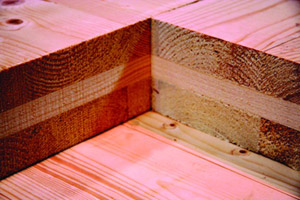Materials Matter
 |
The LifeCycle Tower system was conceived as a way to maximize the use of timber for buildings up to 30 stories. Photo courtesy of www.creebyrhomberg.com |
Michael Green, MAIBC, AIA, MRAIC, Principal of Michael Green Architecture in Vancouver, British Columbia, Canada, believes that, "All materials have their place, and no material is an all-out winner." But for Green, the overriding issue is carbon. "More than five percent of the carbon we put into the atmosphere comes from concrete.4 Steel, too, has a heavy environmental impact. As architects we have to ask ourselves: is there a material that minimizes or eliminates carbon in the environment? While some of the actual numbers in these analyses may be arguable, what's not in doubt is that wood stores carbon, and that it's our only carbon-neutral structural option."
As it turns out, architects are asking themselves that question. For example, carbon reduction was a primary goal for CREE GmbH, which created the timber-based LifeCycle Tower (LCT) system for buildings up to 30 stories. Built around a central stiffening core for the elevator, stairs and shafts, the system includes prefabricated wood/concrete panels supported on the exterior by glulam posts. To date, it has been used for an eight-story building in Austria, and other projects are on the horizon. CREE claims that, compared to conventional construction, the aptly named LifeCycle Tower will require less than half the time to build and see a 90 percent reduction in carbon emissions. Busby, who calls the tower "amazing," says, "The technology to use wood in taller buildings is there. British Columbia relaxed its codes to allow six-story wood buildings. As we see more changes in this direction, we'll see taller buildings in wood."
Moving Ahead
 |
Cross-laminated timber will provide increased opportunity to use wood in commercial structures. Photo courtesy of FPInnovations |
In terms of concrete, research out of the Massachusetts Institute of Technology indicates that Insulated Concrete Form (ICF) homes have been shown to provide 20 percent energy savings in the form of reduced heating, cooling and ventilation needs as compared to conventional wood-framed construction.5 The findings also note, "There are measurable differences between alternative construction systems, and that the thermal mass of concrete can provide energy savings over a life cycle of 75 years." While ICF technology has been around for some 50 years, only recently has there been a significant increase in ICF structures in cost-sensitive commercial, industrial and multi-family markets.
Technical innovations in wood, too, involve increased potential in the commercial sector. Architect Michael Green is part of the emerging movement to consider wood as a building material for larger, taller commercial structures. Together with Eric Karsh of Equilibrium Consulting, Green published The Case for Tall Wood Buildings: How Mass Timber Offers a Safe, Economical and Environmentally Friendly Alternative for Tall Building Structures. As a rationale for the expanded use of wood, he points to the new generation of mass timber products such as cross laminated timber (CLT), which have already gained wide acceptance elsewhere in the world. CLT has been used to build (among others) a 10-story apartment building in Australia and eight- and nine-story buildings in the United Kingdom, and is now available to North American building designers.
Green sees new structural opportunities for wood beginning to mushroom, much like they did more than a century ago with the advent of steel. "We're looking at radically new systems made of wood that make sense from a carbon, sustainability and forestry standpoint and that are realistic competitors to steel and concrete," says Green.









